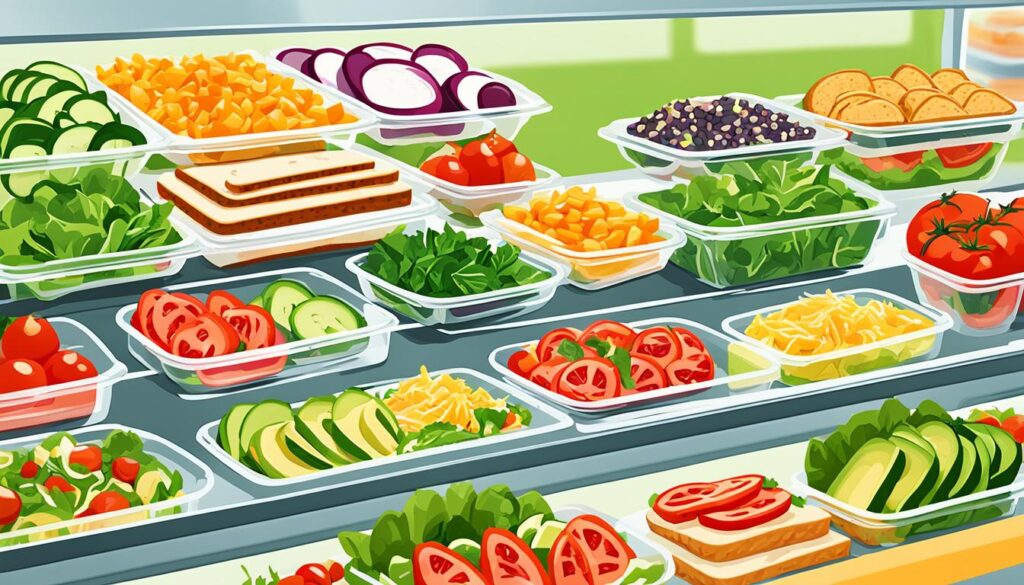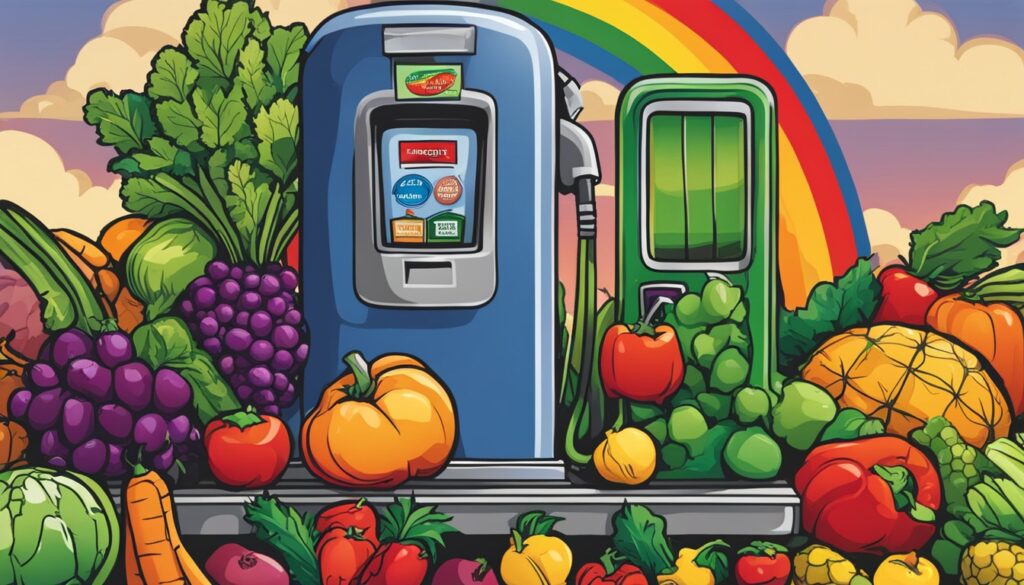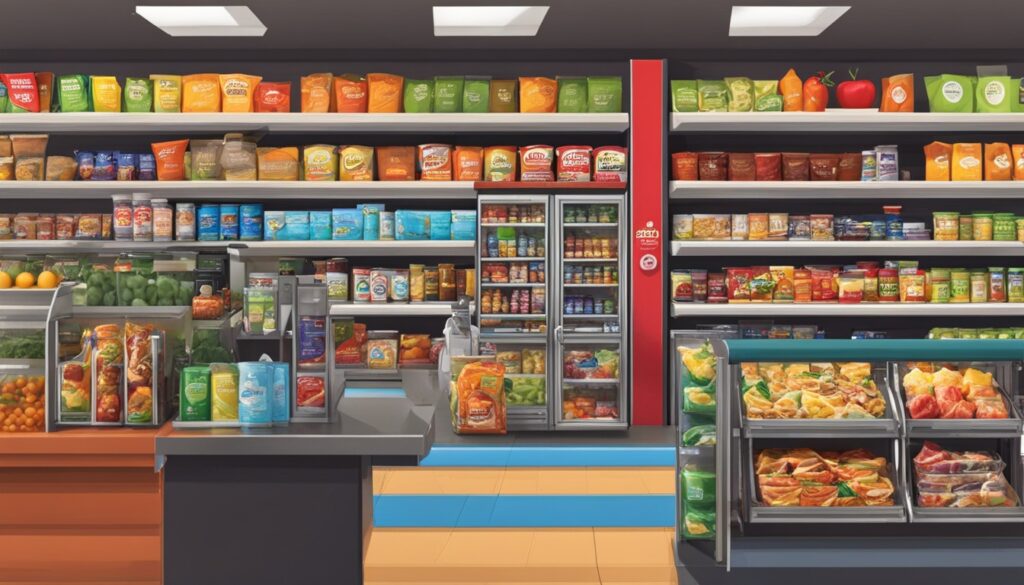Gas stations are changing to meet new dietary trends and health awareness. Today’s consumers want more than just fast food. They look for on-the-go meal solutions that fit their health needs. Convenience stores must offer a wide range of healthy options to attract customers.
A food sales broker can help gas stations improve their food choices. These brokers can find products that fit different diets, like gluten-free or vegan options. This is key to making gas stations a go-to spot for quick, healthy meals.
About 88% of Americans use their cars for grocery shopping. For those struggling with food security or living in areas with few healthy options, gas stations are crucial. With over 44 million Americans on SNAP benefits, gas stations can make a big difference in health and community well-being.
Understanding the Shift in Consumer Eating Habits
There’s a big change in how people eat today. More people know about the dangers of some foods and how they affect health. This has led food sellers, even at gas stations, to offer healthy food choices. These places are visited by millions every day, making it key to meet their new food needs.
People are eating healthier because they know more about the risks of some foods. Studies and surveys during the COVID-19 pandemic have shown this change. For instance, in Poland and Croatia, people chose foods that help their health and boost immunity during the pandemic.
This move towards healthy eating is not just a trend. It’s a real change in response to the growing health issues worldwide. Adding healthy food choices to meals at places like gas stations is a way to answer what customers want. It could also help improve public health. By doing this, gas stations can meet market needs and support community health.
So, it’s important for these places to watch global and local trends to quickly change their menus. This helps them meet customer needs and tackle health issues. It could even lower the future global burden of disease linked to bad diets.
Health Concerns Driving Demand for Better Nutrition Options
Food insecurity and the rise of noncommunicable diseases are making people look for healthier food choices. This includes finding better options at places like gas stations. Obesity, Type 2 diabetes, and heart diseases are linked to poor nutrition.
Nutrition education is key to helping people choose healthier foods. Ultra-processed foods, full of fats, sugars, and preservatives, are common in fast food. But, there’s a growing need for fast food alternatives. This could lead to new policies and products that make eating out healthier.
Gas stations could be key to fighting chronic diseases through better food choices. Offering healthy fast food can really change how people eat. These places are great for teaching people about nutrition, especially for those struggling with food security.
By adding healthier options and nutrition facts, gas stations can become places for learning. They go from just being quick food spots to helping fight the bad effects of poor eating habits. This could make a big difference in public health.
The Role of Gas Stations as Partner in Convenience Food
Modern life makes us all look for quick and easy meal options. Gas stations are becoming key in this area as convenient food suppliers. They’re not just for filling up cars but also for feeding people with ready-to-eat meals. With so many people leading busy lives, having healthy food choices at gas stations is a big plus. It makes these stops essential, not just convenient.
More millennials are shopping at gas stations, and they care about health and nutrition. This has led gas stations to offer healthier food options. They now provide a variety of foods that are good for you, meeting the need for quick and healthy meals.
Gas stations in busy areas are becoming key places for nutrition. They have everything from tasty sandwiches to fresh fruits. This helps people who are always on the move but still want to eat well. It makes customers happy and helps gas stations look good as convenient food suppliers.
Gas stations are changing to be more than just places to get gas. They let you fuel up and grab a healthy meal at the same time. This change shows how important they are in today’s food world. They meet the old need for car fuel and the new trend of eating on the go.
Integrating Healthier Ready-to-Eat Meals in Gas Stations
Gas stations are becoming key spots for busy people. Working with grab-and-go food suppliers and private label frozen food manufacturers is crucial. These partnerships help offer healthy meals that are tasty and easy to grab.
Strict quality control measures are key to this change. They keep food safe and meet nutritional standards. This way, gas stations build trust and keep customers happy.

In rural areas and places like Native American reservations, gas stations are important for getting healthy food. They can offer nutritious choices, helping to fight health issues like diabetes and high blood pressure.
More people are choosing private label frozen food manufacture. This lets gas stations offer meals that fit different diets and tastes. It makes gas stations a go-to for quality, safe, and tasty food.
By adding healthier food options, gas stations are becoming key players in the market for quick, healthy meals. This move matches modern eating habits and the need for nutritious, easy food. It changes how people see gas stations in the food world.
Case Studies: Successes in Gas Station Food Offers
In today’s changing market, success stories from gas stations show how they meet consumer needs. They offer healthier food options because more people want organic and natural foods. This meets the needs of different diets.
Private label frozen foods are key in these changes. They offer convenience and cater to many consumer preferences. This includes vegan, gluten-free, and organic choices. These products help people eat healthier without giving up convenience.
Working with food brokers and distributors helps gas stations reach more people. This partnership ensures they have the quality ingredients needed for their food. It builds trust with customers and keeps them coming back.
These success stories show how well gas stations adapt to the market. They’re becoming places for quick, healthy meals. This change is made possible by working with food distributors and listening to what customers want.
Challenges and Opportunities for Quick Meal Solutions Providers
The quick meal solutions market faces big nutritional challenges and lots of market opportunities. Working with a food sales broker or being a convenient snack partner gives a big advantage. These partnerships help spot and grab market chances, create new products, and meet changing consumer diets.

Today, people are always on the move, making the need for varied meal options grow. Providers must offer everything from grab-and-go to meals you can make yourself. They need to cater to different groups, like Healthy Family Cooks and Gut Stuffing Indulgents. Each group has its own needs and likes, which meal solutions must meet to succeed.
Distributors and makers struggle with getting meals to stores, especially hot and cold ones that must stay fresh. Working together is key, say food experts, to beat the challenges. Better teamwork and planning can help get meals to supermarkets and gas stations on time.
The way forward is to use the skills of food sales brokers and build strong partnerships as convenient snack partners. These partnerships make things run smoother and help with new ideas. They also help meet consumer needs, as seen in the FMI report. Finding the right mix of new ideas and practical delivery will be key to winning in this competitive field.
Impact of the Frozen Food Industry on Gas Station Offerings
The frozen food industry has changed what people expect at gas stations. Now, these places offer more than just fuel and snacks. They have become key spots for quick meal solutions, thanks to the convenience food evolution and healthy eating trends.
Busy lives make people look for fast and nutritious food. Gas stations now have a wide range of frozen meals, including gluten-free, low-calorie, and vegan options. This meets different diets and follows healthy eating trends that focus on wellness and nutrition.
Food sales, including prepared items and drinks, make up 22.6% of what’s sold at U.S. convenience stores. The frozen food industry plays a big part in this, showing strong recovery after the pandemic. This is thanks to new ideas and a focus on quality and safety.
Gas stations now offer fresh, convenient, and quick food options. These changes meet what customers want today. They’re key to making convenience stores‘ food services profitable.
Using frozen food well helps with managing stock, cutting waste, and setting fair prices. This benefits both the store and the customer.
The frozen food industry is crucial in making gas stations full-service quick meal solutions providers. These changes are setting new standards in convenience food retail. They meet customer needs for convenience and quality, and help the foodservice part of gas stations grow.
Strategic Ingredient Sourcing for Special Diets
Health-conscious consumers are changing what food gas stations offer, especially for those with dietary restrictions. Ingredient sourcing specialists are key to this change. The D.D. Reckner Co., with over 58 years of experience, leads the way. They work in many areas, from K-12 food services to nonfoods, making sure there’s food for everyone, including those with gluten-free, vegan, or low-sodium diets.
The D.D. Reckner Co. showed strength during the COVID-19 pandemic by keeping and growing their team. They also found new suppliers for products. This skill is vital for gas stations to offer food for special diets. Marvell Foods, with over 30 years of experience, is another big help. They work directly with many manufacturers to offer advice on surplus food. This helps gas stations stock up on quality food for health-conscious consumers with strict diets.
Gas stations need to work with experts like The D.D. Reckner Co. and Marvell Foods to meet the needs of consumers with dietary restrictions. These partnerships ensure a wide range of branded and unique products. This approach not only attracts more customers but also keeps them coming back. It makes these gas stations go-to places for diverse and appealing food options.

